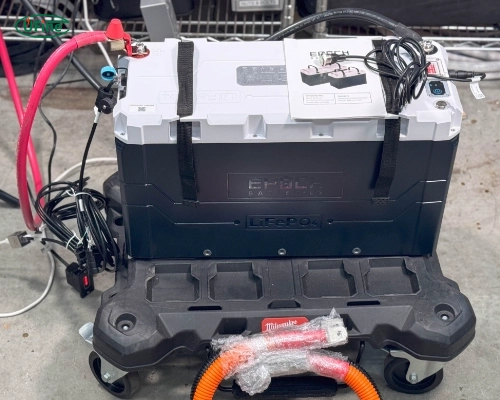
- Part 1. Why battery strap down safety matters
- Part 2. Choosing the right battery strap down system
- Part 3. Installation best practices for battery strap down
- Part 4. Common mistakes in battery strap down and how to avoid them
- Part 5. Routine inspection and maintenance of battery strap down
- Part 6. Special considerations for lifepo₄ batteries with battery strap down
- Part 7. Environmental factors to consider in battery strap down use
- Part 8. Step-by-step battery strap down installation guide
- Part 9. Recommended battery strap down types for maximum safety
- Part 10. Key takeaways on battery strap down systems
Securing a battery is more than just keeping it in place—it’s about ensuring long-term performance, safety, and reliability. Improper installation or poor strap-down practices can lead to vibration damage, terminal stress, or even internal battery failure, particularly for sensitive chemistries like LiFePO₄, NMC, or LCO batteries.
This guide provides detailed safety tips, best practices, and professional recommendations for installing and maintaining battery strap-down systems. It is suitable for marine, RV, solar, off-road, and portable lithium battery applications.
Part 1. Why battery strap down safety matters
Batteries experience:
- Vibration from engines, movement, or transport
- Shock from rough terrain or sudden impacts
- Thermal expansion and contraction due to charge/discharge cycles
Improperly secured batteries can cause:
- Terminal bending or cracking
- Loose busbars or solder joints
- Damage to BMS modules
- Reduced cycle life
- Risk of short circuits
- Safety hazards for equipment and users
Even minor movement or vibration can accelerate wear over time. For LiFePO₄ batteries, vibration damage is one of the most common causes of early failure, because lightweight cells transmit motion directly to internal components.
Artikel Terkait: Battery Strap Down Guide: Types, Uses and Selection Tips
Part 2. Choosing the right battery strap down system
1 Material Considerations
- Nylon or polyester webbing: Lightweight, strong, and flexible.
- Marine-grade straps: UV-resistant for outdoor and marine use.
- Velcro or hook-and-loop: Ideal for small or portable lithium batteries.
- Elastic or padded straps: Absorb vibration and reduce direct stress.
Avoid:
- Bare metal straps or chains
- Thin bungee cords
- Narrow straps (<20 mm wide)
2 Width and Surface Contact
- Straps should be 25–30 mm wide minimum.
- Wide straps distribute force evenly over the battery case, reducing localized pressure points.
- Use padded contact surfaces to avoid scratches or dents.
3 Tension Adjustment
- Tighten straps only until the battery no longer moves.
- Over-tightening can compress the casing, stress terminals, and damage internal cells.
- Periodically check tension, especially after transport or vibration-heavy activities.
Part 3. Installation best practices for battery strap down
1 Positioning the Strap
- Place straps across the midsection of the battery, away from the BMS or terminals.
- Ensure straps do not pinch wires or sensors.
- For large batteries, use dual straps to prevent tipping or side-to-side movement.
2 Using Padding
- Place rubber, EVA, or silicone padding under the battery to absorb vibration.
- Padding reduces sliding, noise, and resonance inside battery boxes or trays.
- Use corner protectors to prevent strap edges from rubbing directly on the battery case.
3 Vibration Isolation
- For marine or off-road applications, consider elastic or shock-absorbing straps.
- Avoid rigid metal brackets unless the battery is heavy and stationary.
- Combining straps with padding ensures vibration is absorbed rather than transmitted to sensitive cells.
4 Terminal Protection
- Keep straps away from battery terminals to avoid bending or stressing posts.
- Ensure cables have proper slack and are not forced against the strap.
- Use insulated terminal covers for extra protection.
5 Securing BMS Components
- BMS modules, temperature sensors, and wiring must remain free from compression.
- Check that the strap does not interfere with any monitoring or balancing circuitry.
Part 4. Common mistakes in battery strap down and how to avoid them
| Mistake | Risk | How to Fix |
|---|---|---|
| Over-tightening strap | Case deformation, terminal stress | Tighten only until battery is secure |
| Using narrow straps | Concentrated pressure points | Use 25–30 mm wide straps |
| Metal chains or brackets | Scratches, short-circuit risk | Use non-conductive straps |
| Straps over terminals | Bending, connection loss | Position straps away from terminals |
| No padding | Excess vibration | Add EVA, rubber, or silicone pads |
| Loose straps | Battery movement, vibration | Check and re-tighten regularly |
| Strap on BMS | Damage to electronics | Keep strap off BMS and wires |
Part 5. Routine inspection and maintenance of battery strap down
- Weekly or monthly check for fraying, UV damage, or loss of tension.
- After transport, inspect straps and retighten if needed.
- Replace worn or damaged straps immediately.
- Check battery casing for indentations or scratches, which may indicate excessive pressure.
- Ensure terminal connections remain secure and free from stress.
Part 6. Special considerations for lifepo₄ batteries with battery strap down
LiFePO₄ batteries require additional attention because of their lightweight design, rigid casing, and sensitive terminals:
✅ Tips:
- Use wider straps with padding to reduce pressure on the casing.
- Avoid rigid brackets unless using a reinforced mounting tray.
- Dual strap configuration is preferred for horizontal movement prevention.
- Elastic or semi-elastic straps absorb vibration without over-compressing cells.
- Ensure BMS and wiring are clear of strap pressure.
Proper installation extends battery lifespan and reduces the risk of voltage drops caused by loose or stressed terminals.
Part 7. Environmental factors to consider in battery strap down use
- Marine/Outdoor Use: UV-resistant, waterproof straps prevent deterioration.
- Temperature Extremes: Check strap material tolerance to heat and cold; straps that lose elasticity can loosen.
- Chemical Exposure: Avoid straps that react with battery electrolytes, acids, or cleaning agents.
Selecting straps designed for the specific environment ensures long-term battery protection.
Part 8. Step-by-step battery strap down installation guide
Prepare the battery tray or box
Ensure the mounting area is clean, stable, and sized for your LiFePO4 battery.
Artikel Terkait: LiFePO4 Compatibility Guide
Place padding under the battery
Add EVA or foam padding to reduce vibration and improve stability.
Position the battery correctly
Ensure terminals, BMS, and wiring areas are kept away from potential strap pressure.
Place the strap across the midsection
Align the universal strap at the center area of the battery for balanced compression.
Tighten the strap correctly
Secure the strap firmly, ensuring the battery is stable but not compressed or deformed.
Test for movement
Check that the battery does not slide, tip, or shift under moderate hand force.
Inspect terminals and wiring
Verify that all cables have adequate clearance and are not strained by the strap.
Recheck after first use
Inspect strap tension and battery stability after initial operation and periodically afterward.
Part 9. Recommended battery strap down types for maximum safety
| Strap Type | Best Use Case | Notes |
|---|---|---|
| Nylon webbing with buckle | RV, solar, portable packs | Adjustable, wide, distributes pressure |
| Hook-and-loop / Velcro | Small LiFePO₄ batteries | Easy to install/remove |
| Marine-grade polyester | Boats, kayaks | UV and water-resistant |
| Elastic composite strap | Shock absorption | Moderate tension recommended |
| Padded ratchet strap | Heavy stationary batteries | Only for non-compressible cases |
Part 10. Key takeaways on battery strap down systems
- Battery strap down safety is critical for preventing vibration damage and terminal stress.
- Lithium batteries are sensitive to over-compression and vibration; proper strap selection is essential.
- Use wide, flexible, padded straps rather than rigid brackets whenever possible.
- Position straps away from terminals and BMS.
- Regularly inspect straps for wear, tension, and damage.
- Environmental factors (marine, UV, temperature) affect strap durability and performance.
- For high-vibration or critical installations, consider custom strap-down solutions designed for the exact battery model.
Related Tags:
More Articles

Do Lithium Batteries Require Special Strap Downs? (Safety + Vibration Control)
Discover why lithium batteries require special strap downs to prevent vibration damage, terminal stress, and internal component issues.
How to Choose a Good 18650 Battery with Reliable Quality?
Battery quality defines performance and safety. Ufine Battery shares how to source good 18650 batteries and avoid unstable suppliers.
Can I Use a Universal Battery Strap Down on LiFePO4 Batteries? (Compatibility Guide)
Learn whether universal battery strap downs are compatible with LiFePO4 batteries, and how to install them safely for vibration control.
Battery Strap Down vs Battery Hold-Down Bracket: What’s the Difference?
Compare battery strap downs and hold-down brackets. Learn key differences, installation tips, and which is safer for lithium batteries.
Battery Strap Down: What It Is, Why It Matters, and How to Choose the Right One
Learn what battery strap downs are, why they matter, and how to choose the right one for lithium and lead-acid batteries safely.




